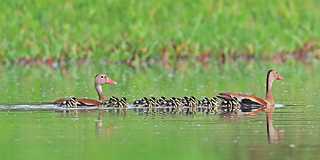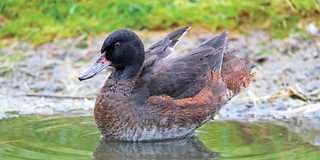Understanding Waterfowl: The Art of Deception
Brood parasitism is more common among waterfowl than you might think
Brood parasitism is more common among waterfowl than you might think
By J. Dale James, Ph.D.
Waterfowl have developed many behavioral adaptations that occur throughout their life cycle, from the selection of mates and nest sites to migration and foraging strategies. All these adaptations in some way help increase the birds' survival and sustain their populations. One of the most interesting behavioral adaptations among waterfowl, which occurs during the egg-laying portion of the breeding cycle, is brood parasitism.
For both waterfowl and humans, raising young is costly in time and energy. Brood parasitism is the act in which birds avoid many of these parental costs by laying eggs in the nests of other birds, who then incubate and raise the parasitic offspring along with their own. While brood parasitism is among the rarest reproductive strategies in the bird world, a surprising number of waterfowl species use this strategy. Unlike the mockingbirds or blue jays in your backyard, ducks do not defend the immediate vicinity of their nests during the laying period, which allows easier access to nest sites by parasitic females.
There are two forms of this behavior: conspecific (or intraspecific) brood parasitism, in which eggs are laid in the nests of the same species, and interspecific brood parasitism, in which eggs are laid in the nests of other species. Some species do both, and so-called "dual strategists" may lay eggs in other birds' nests and then lay and incubate eggs in their own nests.
Conspecific brood parasitism, often referred to as dump nesting, is the most common form of this behavior in waterfowl. More than one-third of the 200 avian species that routinely use this strategy are waterfowl. It's especially prevalent among North America's cavity nesters, such as wood ducks, goldeneyes, buffleheads, mergansers, and black-bellied whistling ducks. Rates of brood parasitism reported among these species range from 5 to 8 percent in buffleheads to greater than 90 percent in certain populations of wood ducks and black-bellied whistling ducks.
Interspecific brood parasitism is much less common among waterfowl. In North America, the species best known for this strategy is the redhead. Researchers on Manitoba's Delta Marsh found that in some years more than 90 percent of canvasback nests were parasitized by redheads and upwards of 50 percent of the eggs present in canvasback nests were those of redheads. But redheads target other nesting waterfowl as well, including both diving and dabbling ducks. Remarkably, redheads raised by other species are aware of their identity and join flocks of their own kind after fledging.
At high rates, brood parasitism can have negative effects on host species. Altercations at the nest between host and parasitic hens can result in damaged eggs, and, in extreme cases, nest abandonment. In addition, incubation efficiencies may be reduced if too many eggs are laid in a single nest. At low levels, however, this behavior can be beneficial to both host and parasite. In what is known as the "selfish herd" effect, brood parasitism may benefit hosts by increasing overall duckling production, diluting the risk of predation of the host's young through sheer numbers. In addition, among ducks with high nest-site fidelity, several closely related females (i.e., sisters, mothers, and daughters) may regularly nest in close proximity to each other. In these cases, the costs of brood parasitism would be reduced as the hosts would be rearing the young of closely related individuals who carry the same genes.
Regardless of what drives this behavior, it's easy to see why some waterfowl species have adopted brood parasitism as a reproductive strategy. If someone else is doing the incubation and brood rearing, hens can devote more energy to staying alive or, in the case of dual strategists, producing and laying their own optimally sized clutches. By laying eggs in different nests, these females reduce the chances of losing all their reproductive effort if their own nest is destroyed, and in environments with unpredictable habitat availability, they can freely seek out needed foraging resources and not be constrained by having to watch their ducklings. While these birds might not win any awards for their parenting skills, what ultimately matters in nature is the perpetuation of their genes, by any means.

GARYKRAMER.NET
Black-bellied whistling ducks regularly parasitize the nests of members of their own species.
Some bird species, known as obligate brood parasites, forgo nesting altogether and rely entirely on other species to incubate their eggs. Yellow-billed cuckoos and cowbirds are well-known examples of this behavior. Among waterfowl, only one example of a true obligate parasite exists: the black-headed duck. This South American species chooses a wide range of hosts to incubate its eggs but is particularly fond of the rosy-billed pochard. Black-headed ducks also parasitize the nests of fulvous whistling ducks, coots, and even herons, ibises, gulls, and snail kites. Interestingly, the parasitic offspring of the black-headed duck do no harm to their hosts, as the ducklings are completely independent and fledge soon after hatching.

GARYKRAMER.NET
The black-headed duck relies entirely on other birds to incubate its eggs.
Ducks Unlimited uses cookies to enhance your browsing experience, optimize site functionality, analyze traffic, and deliver personalized advertising through third parties. By continuing to use this site, you agree to our use of cookies. View Privacy Policy